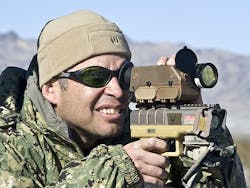The U.S. Army chooses DRS to build the LLDR 3 electro-optical target designation and laser range finder
Officials of the Army Contracting Command at Aberdeen Proving Ground, Md., announced a $231.5 million 10-year contract to DRS on Friday for the Lightweight Laser Designator Rangefinder (LLDR) 3 program.
The LLDR 3 is to be a man-portable, crew-served, ground-based target designation device for precision long-range target acquisition, target location, laser designation, and laser spot imaging with an all-weather day and night precision targeting capability.
It is to be a modular, tripod-mounted target observation, location, and designation system for forward observers as part of a fire support team, scouts, and others to execute “call-for-fire” missions including those for precision-guided, laser guided, and all other munitions.
The LLDR 3 also will help guide laser seeker-equipped aircraft to high-value targets. When connected to a forward-entry system the LLDR 3 will forward information to higher authorities.
Related: Marine Corps makes $11.2 million order to Kollsman for electro-optics laser rangefinders
The electro-optical system will have three separate modules: a targeting locator module; long-range thermal imaging module; and a laser designator module.
DRS will design and integrate 15 units, tested and qualified for production, no later than September 2020, followed by initial production and full-rate production of the LLDR 3. The program will last for 120 months, or 10 years.
As with many military technology programs, LLDR 3 requires a diminishing manufacturing sources and material shortages (DMSMS) program using a risk-based approach for electronics, commercial off-the-shelf (COTS) items, firmware, operating systems, and software. DRS engineers will take corrective actions to mitigate obsolescence.
Despite the presence of other military electro-optics houses that specialize in lightweight laser designator rangefinder systems, such as Kollsman Inc. in Merrimack, N.H., and the Northrop Grumman Corp. Electronic Systems segment in Apopka, Fla., Army officials say they received only one bid -- that of DRS -- for the LLDR 3 program.
For more information contact DRS Network & Imagining Systems online at www.leonardodrs.com/locations/leonardo-drs-melbourne-fl, or the Army Contracting Command-Aberdeen Proving Ground at http://acc.army.mil/contractingcenters/acc-apg
Ready to make a purchase? Search the Military & Aerospace Electronics Buyer's Guide for companies, new products, press releases, and videos
